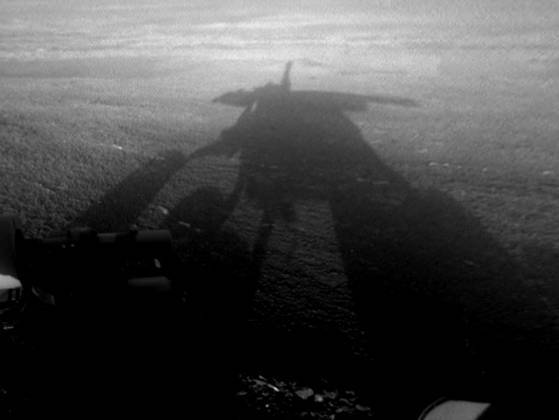
NASA is headed to Mars again.
The space agency said Tuesday it plans to launch another mega-rover to Mars in 2020 that will be modeled after the wildly popular Curiosity. To keep costs down, engineers will borrow Curiosity's blueprints, build from spare parts where possible and use proven technology including the novel landing system that delivered the car-size rover inside an ancient crater in August.
The announcement comes as NASA reboots its Mars exploration program during tough fiscal times.
``If we act now, we can build one at the lowest possible price,'' NASA sciences chief John Grunsfeld said in an interview.
Like Curiosity, the mission will be managed by the NASA Jet Propulsion Laboratory, but many other details still need to be worked out including where the rover will land and what instruments it will carry to the surface.
While the science goals are still fuzzy, NASA said the rover at the very least should kickstart a campaign to return Martian soil and rocks to Earth _ a goal trumpeted by many scientists. The current rover doesn't have that capability.
Despite Curiosity's successful landing, the road to the launch pad was bumpy. At $2.5 billion, the project ran over schedule and over budget.
Jim Green, director of NASA's planetary science division, said the engineering hurdles have been fixed and he expected the new rover to cost less. One independent estimate put the mission at $1.5 billion, though NASA is working on its own cost estimate.
The red planet will see a flurry activity over the next several years. Next year, NASA plans to launch an orbiter to study the atmosphere followed by a relatively low-cost robotic lander in 2016. (AP)
<관련 한글 기사>
화성에서 뭘 발견했길래? NASA, "또 간다"
NASA가 다시 화성 탐사에 나선다.
NASA는 ‘큐리오시티(Curiosity)’를 본 딴 메가탐사로봇을 2020년 화성에 보낼 것이라고 화요일 발표했다. 비용 절감을 위해 엔지니어들은 ‘큐리오시티’호의 청사진을 채택하고, 자동차 크기의 탐사로봇을 분화구에 넣는 새로운 착륙 시스템과 같은 새로운 기술을 도입할 예정이다.
재정적 어려움을 겪고 있는 와중 NASA가 화성탐사프로그램에 재시동을 거는 것에 따라 구체적 계획을 발표할 예정이다.
“지금 한다면 우리는 최저비용으로 하나를 지을 수 있을 거에요.”라고 NASA 사이언스의 대표인 존 그런스펠드(John Grunsfeld)가 말했다.
‘큐리오시티’호와 마찬가지로 NASA 제트 추진 연구소가 미션을 관리할 것이다. 그러나 탐사로봇이 어디로 착륙하고 어떤 기구를 가져갈 것인지 등과 같은 세부사항 여러가지가 미결정 상태에 있다.
본 프로젝트에 대한 목표가 아직 불투명한 반면 NASA는 탐사로봇이 최소한 화성의 토양과 바위를 지구로 가져오는 캠페인을 할 것이라고 밝혔다. 이는 많은 과학자들이 자랑스럽게 여기는 일이다. 현재 사용되는 탐사로봇은 이 역할을 수행하지 못한다.
‘큐리오시티’가 성공적으로 착륙을 했음에도 불구하고 착륙할 당시 지표면이 매끄럽지 못했다. NASA는 이 문제를 해결하기 위해 2조 7천 억 원의 추가 예산을 쓸 계획이다.
NASA의 행성탐사를 맡고 있는 짐 그린(Jim Green)은 기술적 장애물들은 해결이 되었으며, 새로운 탐사로봇에는 비용이 더 적게 될 것으로 예상한다고 말했다. 일각에서는 이번 미션에 1조 5천 억 원이 들 것이라고 예상했다. NASA는 비용 견적 연구를 독립적으로 해오고 있다.
다음 수 년 동안 화성을 겨냥한 프로젝트가 여러 가지 수행될 예정이다. NASA는 내년에 궤도 선회 우주선을 발사할 계획이다. 이에는 비교적 적은 비용의 로봇 착륙기가 2016년 대동한다.
한편 NASA는 지난 3일 ‘큐리오시티’가 최초의 토양 전면 분석을 통해 복잡한 화학작용의 흔적과 생명체 구성의 기본물질인 탄소 함유 유기화합물의 단서를 발견했다고 발표했다.
그러나 이것이 실제로 화성의 것인지, 아니면 지구로부터 묻어온 오염물질인지 여부는 아직 밝혀지지 않았다. (코리아헤럴드)












![[Today’s K-pop] BTS pop-up event to come to Seoul](http://res.heraldm.com/phpwas/restmb_idxmake.php?idx=644&simg=/content/image/2024/04/17/20240417050734_0.jpg&u=)




![[KH Explains] Hyundai's full hybrid edge to pay off amid slow transition to pure EVs](http://res.heraldm.com/phpwas/restmb_idxmake.php?idx=652&simg=/content/image/2024/04/18/20240418050645_0.jpg&u=20240419100350)

![[Today’s K-pop] Zico drops snippet of collaboration with Jennie](http://res.heraldm.com/phpwas/restmb_idxmake.php?idx=642&simg=/content/image/2024/04/18/20240418050702_0.jpg&u=)